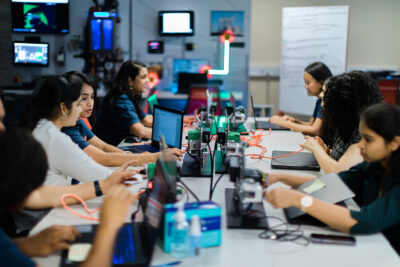Posted on November 2, 2023 by Wendy Frost
 The undergraduate and graduate cyber security degree programs in the college have grown over 70% in the past five years — going from 1,238 students to 2,210 today. The students are enrolling in programs that include a bachelor’s degree in cyber security, an online bachelor’s degree in cyber security, a master’s degree in information technology with a cyber security concentration and a doctoral degree with a concentration in information technology.
The undergraduate and graduate cyber security degree programs in the college have grown over 70% in the past five years — going from 1,238 students to 2,210 today. The students are enrolling in programs that include a bachelor’s degree in cyber security, an online bachelor’s degree in cyber security, a master’s degree in information technology with a cyber security concentration and a doctoral degree with a concentration in information technology.
“What surprises most people is that our programs are located in a business school, but this is intentional,” said Nicole Beebe, UTSA professor of information systems and cyber security. “UTSA students receive fundamental business training in addition to highly technical training in cyber security. More importantly, the variety of course work that we offer allows our students to be well-rounded but also to focus in unique specialty areas.”
Cyber security is an extremely diverse field with highly technical specialties such as cryptography and digital forensics as well as disciplines in cyber behavior and policy. The college’s cyber security majors take 36 hours of coursework in cybersecurity, and they can choose from courses in a wide variety of areas such as secure mobile app development, digital forensics, network security, cybercrime investigations, intrusion detection, cyber law, cyber analytics and malware analysis.
A huge selling point of the program was “the prestige and excellent reputation of UTSA’s cyber security program,” said Jeff Miller, an undergraduate cyber security student from Katy, Texas. “As I began to look into the classes I would be taking, I concluded that the business-focused curriculum would be substantial in preparing me for my future career.”
In an effort to reach even more students, UTSA launched a fully online B.B.A. in Cyber Security in 2017. The program, which offers identical content to the residential program, has grown by over 410% to almost 500 students since its founding.
“Students are learning cutting-edge material in a hands-on environment but have greater flexibility as part of our online program,” said Rita Mitra, a cyber security professor who has taught in the online program since its inception. “Cyber classes by nature use virtual machines to simulate various scenarios and computing environments, so online students have the ability to complete the same assignments as students on campus.”
Beebe, who also serves as UTSA’s associate vice president for research and development, added that “our faculty don’t just teach from textbooks. They create custom content that students can’t get anywhere else. Our national No. 1 ranking by Ponemon in 2014 was a pivotal point for us. The timing of the ranking along with the increase in cyber-attacks put our program on the map.”
UTSA is one of the few universities nationally — and only Hispanic Serving Institution — to hold all three National Center of Academic Excellence designations from the National Security Agency and the U.S. Department of Homeland Security.
UTSA’s commitment to innovate as the industry evolves is another way its cyber security program has maintained its dominance in higher education. The newest program offered by the college is a B.S. in Applied Cyber Analytics. Combining analytics and cyber security training, students utilize machine learning and artificial intelligence tools to address cyber threats.
“In 20 years, society will look back at the launch of this degree program and realize how innovative the Alvarez College was in establishing it,” Beebe said. “Cyberattacks are coming so quickly that it is a losing battle for a person to parse through all of that data. But if our students are trained to use analytical tools well, they can recognize attacks much sooner.”
Elizabeth Reyes, a graduate cyber security student was drawn to the program’s emphasis on hands-on experience and real-world applications, which she believes are crucial in the field. “In my Security Risk Analysis class, we have the freedom to explore all the different tools in SimSpace and implement what we learned in the college’s cyber security Lab,” Reyes said.
SimSpace provides a training ground for cyber security students to learn about cyberattacks and practice their skills in a realistic environment. This virtual environment enables them to test their cyber defenses and to prove their processes against the intensity and uncertainty of aggressive cyber adversaries.
As one of the largest cyber and information security cities outside of Washington, D.C., San Antonio ranks second in federal and defense contracting opportunities and its concentration of cyber security professionals.
“As a hub for cyber security and technology, UTSA and San Antonio provide numerous opportunities for networking and internships, which was an important factor in my decision to attend here,” Reyes said.
According to the U.S. Bureau of Labor Statistics, the cyber security sector is expected to grow 32% over the next 10 years with the need for over 700,000 cyber security professionals in the United States alone.
“Over the years, the sheer number and the nature of the companies recruiting at UTSA has vastly improved,” Beebe said. “UTSA students are valued in the marketplace for their knowledge, their skills and their determination to make a difference in this industry.”

